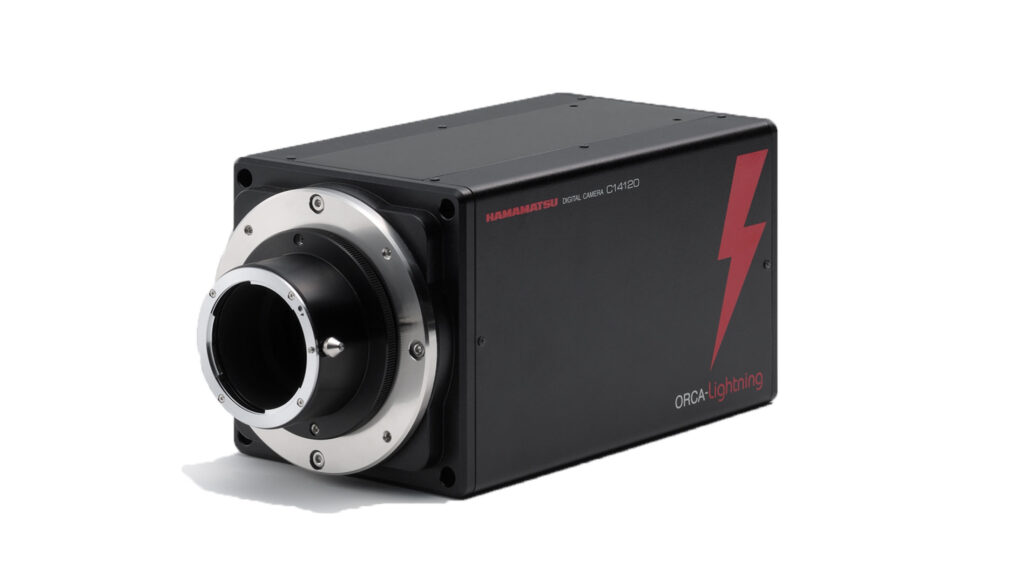Hamamatsu - ORCA-Lightning Digital CMOS camera: C14120-20P
Micrasys e. K.
Owner: Frank Pobig
Panoramablick 11
D-35745 Herborn
Germany
Phone: +49 (0)2772 82466
Mobil: +49 (0)163 7733917
Fax: +49 (0)3212 1220079
Email: info@micrasys.com
Select your country to view all the provider contacts:
Details
Hamamatsu - ORCA-Lightning Digital CMOS camera: C14120-20P
For imaging scientists, inspiration is often found at the edges—at the spatial, temporal, and optical boundaries of a system. It’s that grainy image of the cytoskeleton that has just enough photons to confidently resolve two unique molecules. It’s data extracted from a few pixels, whittled away from a larger array, to achieve capture rates relevant to neuronal signaling. It’s the mesmerizing cellular migrations of a developing embryo, reconstructed from a lightsheet time-lapse, that offer new insights and spark new questions.
By more than doubling speed, resolution and field of view relative to current scientific cameras, the ORCA-Lightning is designed to inspire new frontiers of exploration. Compared to a Gen II sCMOS, the ORCA-Lightning delivers 2 times the pixel area, 2.8 times the pixels and 3.4 times faster pixel-per-second readout.
All these increases translate to the ability to capture more image data faster, and still achieve Hamamatsu-quality images and information content. So whether you’re developing the next cutting-edge lightsheet system or building a library of the mouse connectome, the high throughput of the ORCA-Lightning will get you to your goal faster. And, we hope, open doors to new discoveries.
Features
- High resolution : 4608 x 2592 (12 Megapixels)
- High Speed: 121 frames/s (at full resolution)
- Read noise : 2.0 electrons rms (Standard Full Well Capacity mode)
- Pixel size : 5.5 μm X 5.5 μm
- Dynamic Range 17 000:1 (High Full Well Capacity mode)
- Peak QE : 60 % (at 550 nm)
High-speed imaging
Can even take high-speed images which were difficult to fully capture until now, with approximately 6 times the readout speed, while maintaining a level of readout noise similar to that of ORCA-Flash4.0 V3.
Speed comparison with ORCA-Flash4.0 V3
Cameras used in light-sheet microscopes put emphasis on high speed, demanding fast readout. Because images with increased readout speed result in obtaining fewer photons upon capture, it is necessary to keep the camera’s readout noise low when trying to capture high S/N images. ORCA-Lightning can capture images at approximately 6 times the readout speed, while maintaining a level of readout noise similar to that of ORCA-Flash4.0 V3.
Using CoaXPress as an interface and optimizing high speed data transfer to the PC, ORCA-Lightning realizes high-speed image acquisition.
Readout speed (for each effective number of pixels and modes)
Customers can select the best mode depending on their usage.
In addition to a readout from a Standard Full Well Capacity mode (12 bit), ORCA-Lightning also supports a readout from a High Full Well Capacity mode (16 bit) for high dynamic range.
| Effective number of pixels (H) × (V) |
Readout speed (frames per second) | |||||||
|---|---|---|---|---|---|---|---|---|
| Free running mode *1 | Edge trigger mode *2 | Synchronous readout trigger mode *3 | Global reset trigger mode *4 | |||||
| 12 bit | 16 bit | 12 bit | 16 bit | 12 bit | 16 bit | 12 bit | 16 bit | |
| 4608 × 2592 | 121 | 30 | 121 | 30 | 121 | 30 | 120 | 30 |
| 2688 × 2592 | 208 | 30 | 207 | 30 | 208 | 30 | 207 | 30 |
| 2560 × 2560 | 221 | 30 | 220 | 30 | 221 | 30 | 220 | 30 |
| 2048 × 2048 | 307 | 38 | 305 | 38 | 308 | 38 | 305 | 38 |
| 1024 × 1024 | 610 | 76 | 603 | 75 | 612 | 76 | 600 | 75 |
| 512 × 512 | 1201 | 150 | 1175 | 146 | 1210 | 151 | 1166 | 145 |
| 256 × 256 | 2332 | 291 | 2234 | 279 | 2367 | 295 | 2203 | 275 |
| 128 × 4 | 31 725 | 3965 | 19 828 | 2478 | 39 657 | 4957 | 17 625 | 2203 |
*1 Free running mode is operated via camera alone.
*2 Edge trigger mode starts the exposure by the edge (rising/falling edge) of the trigger signal input to the external device.
*3 Synchronous readout trigger mode ends the exposure of the camera and readout is started, while the next exposure is simultaneously started by the edge (rising/falling edge) of the trigger signal input to the external device.
*4 Global reset trigger mode starts the exposure of all pixels all together by synchronizing the trigger signal from external device.
High speed test of 3D imaging
We took consecutive images and produced 3D imaging of a free-swimming Volvox.
When capturing the image of a free-swimming Volvox, imaging speed of 2-dimensional (area of observation) and 3-dimensional (number of images) settings were selected with a precondition of approximately 8 volumes per second.
With its high speed, ORCA-Lightning can capture clearer images within a wide range compared to ORCA-Flash4.0 V3.






































